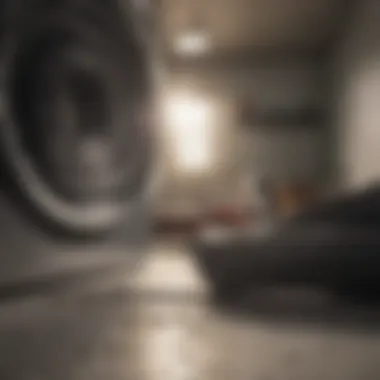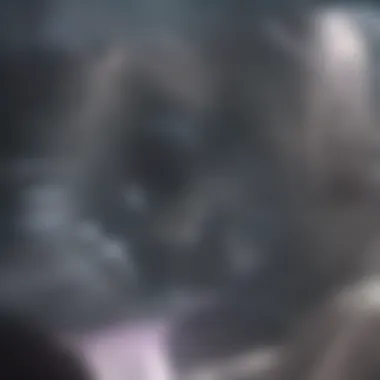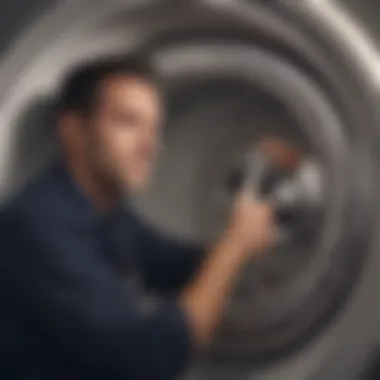Effective Techniques for Cleaning Dryer Ducts


Intro
Cleaning dryer ducts is an integral yet often overlooked aspect of home maintenance. Regular upkeep of these ducts is essential for ensuring the safety and efficiency of your dryer system. Clogged dryer ducts can lead to potential fire hazards and increased energy costs. The buildup of lint and debris restricts airflow, causing dryers to overheat and consume more energy than necessary.
This guide aims to provide homeowners with a comprehensive understanding of the cleaning process, highlighting vital tools, techniques, and safety considerations. Whether you are looking to perform this task yourself or considering hiring a professional, this article will inform you on the best practices for maintaining dryer ducts. Recognizing the relevance of this topic could help prevent accidents and prolong the lifespan of your dryer. Additionally, understanding how often to clean your ducts can enhance energy efficiency and save you money in the long run.
Through this narrative, we will uncover the systematic approach to cleaning dryer ducts, showcasing necessary steps and discussions centered around common tools and safety precautions.
Understanding the Importance of Dryer Duct Cleaning
Maintaining clean dryer ducts is critical for several reasons. The primary function of a dryer duct is to direct hot air and moisture away from the appliance. Over time, lint and debris accumulate in the ductwork, which can lead to serious issues, including reduced efficiency and increased safety risks. Regular cleaning not only enhances the performance of the dryer but also prevents potential hazards that may arise from lint buildup.
One significant benefit of thorough dryer duct cleaning is improved energy efficiency. When lint obstructs airflow, the dryer works harder to remove moisture from clothes. This increased workload translates to higher energy bills. Homeowners can save on utility expenses by ensuring ducts are clear. Additionally, a clean dryer duct allows clothes to dry faster, saving time in daily routines.
How Lint Accumulates in Dryer Ducts
Lint accumulation in dryer ducts occurs as a natural byproduct of drying clothes. When wet fabrics tumble within the dryer, tiny fibers break free, and the dryer's exhaust system collects these particles. The ducts are designed to funnel these lint particles out of the home. However, if the duct system is not regularly maintained, this lint can build up, significantly reducing airflow.
The design of the duct can also influence how much lint accumulates. Long runs of ductwork with multiple bends or kinks trap lint more effectively than straight, short ducts. It's vital to inspect and clean the ductwork routinely to prevent dangerous clogs. Understanding how lint accumulates is the first step in implementing effective cleaning strategies.
Consequences of Neglecting Dryer Duct Maintenance
Neglecting dryer duct maintenance can lead to a series of detrimental consequences. One of the most alarming risks is fire. According to the U.S. Fire Administration, failure to clean dryer vents is one of the leading causes of dryer-related fires. Lint accumulation is highly flammable and can ignite if exposed to hot surfaces within the dryer or duct.
In addition to fire hazards, ignoring duct maintenance compromises appliance efficiency. A clogged duct causes the dryer to overheat, potentially leading to expensive repairs or the need for complete replacement. When moisture does not escape effectively, it can result in the growth of mold or mildew, contributing to health risks for inhabitants.
Homeowners who do not prioritize cleaning their dryer ducts could find themselves facing both safety issues and additional costs over time. Regular inspection and maintenance are essential for preventing such consequences.
Tools and Materials Needed
Understanding the tools and materials needed for cleaning dryer ducts is crucial for effective maintenance. Having the right equipment ensures that the cleaning process is efficient and thorough. Additionally, it minimizes the risk of damage to the ductwork or the dryer itself. Whether one is a seasoned DIYer or someone looking to perform this task for the first time, knowing what to use can enhance the overall experience and outcome.
Essential Tools for Cleaning
When embarking on the task of cleaning dryer ducts, the right tools can make all the difference. These tools not only aid in effectively removing lint and debris but also ensure safety during the process. Here are some essential tools you will need:
- Vacuum cleaner with a hose attachment: A vacuum cleaner is essential for removing built-up lint from the ductwork. Choose one with a strong suction power to efficiently clear out debris.
- Flexible dryer duct cleaning brush: This brush is designed to navigate through the bends and turns of the duct. Its flexible bristles reach places that are otherwise hard to access.
- Screwdriver: A screwdriver is necessary for removing the dryer vent cover or accessing the duct assembly behind the dryer. Make sure to have both Phillips and flathead types.
- Protective gloves: Wearing gloves protects hands from sharp edges and also keeps the cleaning process more hygienic.
- Flashlight: A flashlight helps illuminate the area inside the duct, making it easier to see accumulated lint or any other debris.
These tools are relatively affordable and can be found at local hardware stores or online. Investing in good quality tools can lead to better results and will be helpful for future cleaning sessions.
Recommended Cleaning Materials
In addition to tools, certain materials can enhance the duct cleaning process. These materials help in loosening lint and debris, making it easier to remove them from the duct. Consider the following materials:
- Lint remover: A specialized lint remover can aid in breaking down stubborn lint that accumulates in the ducts. Look for biodegradable options that are safe for both your home and the environment.
- Mildew cleaner: If your ducts have been exposed to moisture, a mildew cleaner can help eliminate mold and fungi. Ensure to use a cleaner that is safe for use in home environments, as residual chemicals can be hazardous.
- Duct tape: While it may seem simple, duct tape plays an important role in securing any loose sections of ductwork after cleaning. It also helps seal any gaps to prevent lint build-up in the future.
- Rags or old towels: Keep some old towels or rags handy to wipe down surfaces or collect lint as it is removed. This keeps the work area clean and tidy.
In summary, having the right tools and materials is foundational in the process of cleaning dryer ducts. It not only simplifies the task but also ensures that it is done effectively and safely. By being prepared, anyone can take confidence in performing this task and maintaining a safe home environment.
Step-by-Step Process to Clean Dryer Ducts


Cleaning dryer ducts is vital for maintaining both safety and efficiency in your home. Clogged ducts can lead to several problems, including reduced performance of your dryer, longer drying times, and even increased risk of fire hazards due to lint accumulation. Understanding the systematic approach to cleaning these ducts allows homeowners to address dust and lint issues effectively. By following a step-by-step process, you can ensure that your dryer operates optimally and safely.
Disconnecting the Dryer
Before starting the cleaning process, it is essential to disconnect the dryer. This step is crucial to ensure safety and prevent any electrical hazards.
- Unplug the Dryer: Locate the power cord and remove it from the outlet. Ensure that there is no electricity flowing to the appliance during the cleaning.
- Move the Dryer: Carefully slide the dryer away from the wall, providing enough access to the ductwork. Be cautious not to damage the flooring while moving the unit. Use a helper if necessary to prevent strain or injury.
This initial step lays the groundwork for accessing the ductwork safely and making the process smoother.
Accessing the Ductwork
With the dryer adequately disconnected, the next step is to access the ductwork. Proper access allows you to thoroughly clean the area without obstruction.
- Locate the Duct: Identify the point where the dryer connects to the duct. This usually includes a vent that extends from the dryer to the exterior of your home.
- Remove Connectors: Depending on your setup, you may need to unscrew or unclip the duct from your dryer. Keep track of any screws or clips as you remove them, ensuring you can easily reassemble everything later.
- Check for Accessibility: Ensure that there are no bends or kinks in the duct that could complicate the cleaning process. If there are, consider a thorough inspection to see if replacements or repairs are needed.
Gaining proper access significantly improves the effectiveness of your cleaning procedure.
Using a Vacuum Cleaner Effectively
Utilizing a vacuum cleaner effectively is an essential part of cleaning dryer ducts. This appliance will help remove lint buildup from both the duct and the dryer vent.
- Select the Right Vacuum: A vacuum with a long hose attachment will be more effective. Ideally, a shop vacuum with powerful suction is preferred for tackling stubborn lint.
- Insert the Hose: Insert the hose into the duct and navigate it as far as possible. Move the hose back and forth gently to dislodge and suck up lint.
- Be Persistent: Continue vacuuming until you don't see any more lint coming from the duct. Take your time during this step to ensure thorough cleaning.
Using the vacuum correctly can greatly enhance the cleaning efforts and remove the majority of the lint.
Brushing Techniques for Thorough Cleaning
While vacuuming is important, brushing techniques will help to dislodge any lint that the vacuum might have missed. This method ensures all debris is removed effectively.
- Choose the Right Brush: A specialized dryer duct cleaning brush works best. These brushes often have flexible handles that can navigate bends and corners.
- Insert the Brush: Push the brush into the duct while rotating it to loosen lint. Make sure to reach as far as possible to remove all buildup.
- Work in Sections: Work in sections, brushing each part thoroughly before moving to the next. This careful approach prevents any accumulation from being overlooked.
The combination of vacuuming and brushing maximizes the cleanliness of your dryer ducts, promoting safer operation.
Reassembling and Testing the Dryer
Once the duct cleaning is complete, it is time to put everything back together and test. Proper reassembly ensures that your dryer will function efficiently without any loose connections.
- Reconnect the Duct: Align the duct back to its original position and securely attach any connectors, screws, or clips that were removed. Ensure a tight fit to prevent drafts.
- Slide the Dryer Back: Gently slide the dryer back into its original position while avoiding any damage to the duct.
- Plug in the Dryer: Reconnect the power supply, ensuring everything is connected securely.
- Run a Test Cycle: Conduct a test run of the dryer on an empty load to check for any issues. Look out for unusual noises or reduced efficiency.
Completing this step means your dryer is now ready for safe and effective operation, proving that regular maintenance can make a significant difference.
Safety Precautions During the Cleaning Process
Cleaning dryer ducts is vital for maintaining efficiency and safety in your home. However, the procedures involved can present certain risks. This is why understanding and implementing safety precautions during the cleaning process is critical. Neglecting such measures can lead to injuries or situations that complicate your cleaning efforts.
Benefits of Safety Precautions
Ensuring safety while you clean protects both you and your home. Using the right equipment reduces injuries from falls or cuts. Furthermore, by avoiding risks associated with electrical systems, you keep your home safe from fires. All of these elements contribute to making the process smoother and more effective.
Personal Safety Equipment


Before starting the cleaning process, gathering personal safety equipment is crucial. This gear helps protect against dust, debris, and potential accidents. Here’s a list of recommended equipment:
- Gloves: Wearing gloves helps prevent skin irritation and cuts.
- Dust mask: A mask filters lint and dust particles, which could cause respiratory issues.
- Safety goggles: Protect your eyes from lint flying into your face during cleaning.
- Knee pads: If you need to kneel, these will protect your knees from hard surfaces.
Having this equipment ready will help ensure your cleaning session is as safe as possible.
Avoiding Electrical Hazards
Electrical hazards are often overlooked but can be extremely dangerous when cleaning dryer ducts. Many dryers are powered by electricity and are connected to potentially live wires. Here are key considerations:
- Unplug the dryer: Always disconnect the dryer from its power source before starting. This simple step significantly reduces the risk of electrical shock.
- Check for frayed wires: Inspect the power cord for any irregularities. Damaged cords can pose serious hazards.
- Avoid moisture: Ensure your hands and tools are dry to minimize the risk of electrocution.
Taking these steps seriously can prevent accidents and ensure that your dryer operates safely after cleaning.
In summary, practicing safety precautions when cleaning dryer ducts is an essential element of the process. Proper personal safety equipment coupled with vigilant attention to electrical safety creates a safer working environment. By implementing these measures, you can approach your duct cleaning task with confidence and focus on the important job at hand.
When to Seek Professional Help
Cleaning dryer ducts is an essential task for maintaining home safety and efficiency. However, there are instances when enlisting a professional service is not only advisable but necessary. Identifying these situations can prevent damage to your home, enhance dryer performance, and ensure your personal safety. Knowing when to call in experts allows you to take action before a minor issue escalates into a significant problem.
Signs Indicating Professional Cleaning is Necessary
Certain signs may indicate that your dryer ducts need the attention of a trained professional. Here are key indicators:
- Reduced Drying Efficiency: If your clothes take longer than normal to dry, this could suggest lint buildup or blockage in the ductwork.
- Increased Heat: Noticing excessive heat emanating from the dryer outside of the normal operating range can signal poor airflow due to duct issues.
- Foul Odors: A burning smell or other unusual odors during operation can represent a serious risk, often linked to overheating lint.
- Visible Lint Buildup: If you observe lint accumulating near the dryer vent or outside vent exit, it is a clear sign that more comprehensive cleaning is needed.
- Frequent Breakdowns: If your dryer is repeatedly malfunctioning, a deeper investigation into the ducting may reveal hidden problems.
By recognizing these signs early, you can avoid fire hazards and costly repairs. If you observe any of these indicators, it's prudent to reach out for professional help immediately.
Choosing the Right Service Provider
Selecting the right professional service for dryer duct cleaning requires careful consideration. Here are important factors to guide your choice:
- Certification and Experience: Ensure the technician has certifications like NADCA (National Air Duct Cleaners Association) accreditation. Experience in handling dryer systems is also crucial for effectiveness.
- Positive Reviews and References: Research customer feedback online or ask for references. Reliable companies often have a track record that demonstrates their competence and service quality.
- Detailed Assessment Process: A thorough company should offer an assessment of your duct system before proceeding. This ensures they identify all issues that may not be immediately visible.
- Clear Pricing Structure: Confirm that the company provides a transparent breakdown of costs, avoiding any hidden fees or surprises at the end.
- Follow-Up Services: Look for service providers who offer maintenance plans or check-ups. Regular inspections can prevent problems from returning shortly after cleaning.
By carefully selecting a professional service based on these criteria, you can ensure that your dryer duct cleaning is completed effectively and safely, thereby improving appliance efficiency and protecting your home.
Establishing a Cleaning Schedule for Your Dryer
Maintaining a cleaning schedule for your dryer ducts is crucial for optimal performance and safety. Regular cleaning helps prevent dangerous lint build-up, reduces the risk of fires, and improves energy efficiency. Having a predictable routine ensures that dryer maintenance becomes part of your household tasks.
Benefits of a Cleaning Schedule
- Enhances Safety: Regular cleaning reduces the risk of fire hazards caused by lint accumulation.
- Improves Efficiency: A clean duct allows the dryer to operate efficiently, thus saving energy and lowering utility bills.
- Extends Dryer Life: Keeping the ducts clear prevents excessive strain on the dryer, which may prolong its lifespan.
Factors Influencing Cleaning Frequency
Several factors determine how often you should clean your dryer ducts. Understanding these elements can help you establish a more effective schedule:
- Frequency of Use: If the dryer is used daily, consider cleaning every three months. For less frequent use, a schedule of every six months may suffice.
- Type of Fabric: Some fabrics shed more lint than others. For instance, towels and blankets generate more lint compared to lighter items. You should adjust your cleaning frequency based on the types of materials being dried.
- Household Size: Larger families may have more clothes being washed and dried, leading to quicker lint build-up. In such cases, more frequent cleaning may be necessary.
- Type of Dryer: Different dryers have varied lint trap and duct designs. Understanding the specific make and model you own can guide you in creating a more tailored cleaning schedule.


Creating a Maintenance Log
A maintenance log is an efficient way to track your cleaning activities and ensure you do not overlook this important task. Keeping records not only helps in scheduling but also aids in recognizing patterns and potential issues. Here are steps to create an effective log:
- Choose a Format: Decide whether you prefer a physical notebook or a digital document.
- Record Dates: Document when the cleaning occurs.
- Note Conditions: Describe the duct's condition before and after cleaning.
- Track Repairs: If any repairs or adjustments were made, write them down.
By maintaining these records, you can easily review your cleaning history, identify trends, and adjust your schedule as needed. This proactive approach ensures that your dryer operates safely and efficiently.
Common Mistakes to Avoid
Avoiding pitfalls during the process of dryer duct cleaning is very important. Small mistakes can lead to bigger issues such as fire hazards or inefficiency in the dryer’s performance. Understanding common mistakes helps in ensuring a safer and more efficient cleaning process, allowing for better maintenance of your appliance.
Using the Wrong Tools
Choosing the correct tools is essential for effective dryer duct cleaning. Using inappropriate tools can not only lead to a less thorough cleaning but can also cause damage to the ductwork or dryer. Homeowners often think that any vacuum cleaner will suffice, but this is not true.
An appropriate tool set for dryer duct cleaning includes:
- Lint brushes for scrubbing interior surfaces.
- Flexible rods that can maneuver through bends in the duct.
- Vacuum attachments designed specifically for this purpose.
Using the wrong tools can leave behind residual lint, which increases fire risk. Furthermore, it can cause the dryer to work harder, resulting in higher energy costs. Always do your research on tools before starting your cleaning process to ensure you have the right ones at hand.
Ignoring Warning Signs
Warning signs of a clogged dryer duct should never be overlooked. Ignoring them can be detrimental to your dryer’s efficiency and safety. Symptoms often manifest subtly at first but can escalate quickly.
Signs to watch for:
- Clothes take longer to dry than usual.
- A burning smell coming from the dryer.
- Excessive heat around the dryer itself.
If you notice any of these indicators, it may be time for a thorough inspection and cleaning of your ducts. Waiting too long could lead to an accumulation of lint that may ignite. The best practice is to take these signs seriously and act promptly, ensuring you maintain a safe home environment.
Environmental Considerations
Understanding the environmental impact of cleaning dryer ducts is essential for promoting responsible home maintenance. This section addresses the relevance of dryer duct cleaning from an ecological perspective, ensuring that homeowners are aware of their choices and the resulting consequences.
Reducing Lint Waste
Lint waste from dryer ducts accumulates not only in your home but also contributes to larger environmental issues. Lint consists mainly of fibers from clothing that shed during the drying process. When not managed properly, this lint can end up in landfills, adding to waste problems. By adopting a regular dryer duct cleaning routine, you address the problem at the source, minimizing the amount of lint that needlessly contributes to waste. Moreover, a clean dryer duct increases the efficiency of the dryer, which means less energy consumption. Reducing energy use helps to lower your home's carbon footprint, supporting broader efforts to combat climate change.
Efficient Disposal Methods
Disposing of lint and debris correctly is crucial to maintaining environmental integrity. Many homeowners are unsure about how to dispose of lint from dryer ducts. One effective method is to compost it, as lint made from natural fibers decomposes over time. However, synthetic fiber lint should be disposed of in regular garbage to avoid contamination in compost. This practice not only keeps your environment clean but also promotes sustainable disposal practices.
Additionally, consider reusing the lint for other purposes. For instance, it can be used to stuff pillows or for other craft projects. Encouraging creativity in disposal methods can inspire others to think beyond conventional waste practices. Therefore, efficient disposal not only addresses immediate waste but also highlights innovative ways to use materials that would otherwise be discarded.
Finale
In any discussion regarding dryer duct maintenance, the conclusion serves to encapsulate the vital information presented throughout the article. One must recognize that regular cleaning of dryer ducts is not merely a chore. It is an essential component of home safety and efficiency. By dedicating time to this task, homeowners can significantly reduce the risk of fire hazards associated with lint accumulation. Moreover, effective duct cleaning enhances dryer performance, leading to reduced energy consumption and extended lifespan of the appliance.
Summary of Key Points
The key points outlined in this guide echo the profound necessity for dryer duct cleaning. The accumulation of lint can lead to dangerous outcomes, which have been clearly articulated. Furthermore, essential tools for cleaning have been identified, along with a straightforward step-by-step process that simplifies the task. Safety precautions are critical and must be prioritized, as neglect can lead to serious consequences. Lastly, consideration of environmental aspects ensures a well-rounded approach to maintenance.
Encouragement for Ongoing Maintenance
It is no longer sufficient to simply clean the dryer ducts once and forget about them. Establishing a routine for maintenance is crucial. Homeowners should take proactive measures by scheduling regular inspections and cleanings. Keeping a maintenance log, as discussed in earlier sections, can significantly aid in this regard. Each cleaning session not only secures safety but also greatly improves drying efficiency, preserving both the appliance’s health and the homeowner's peace of mind.















